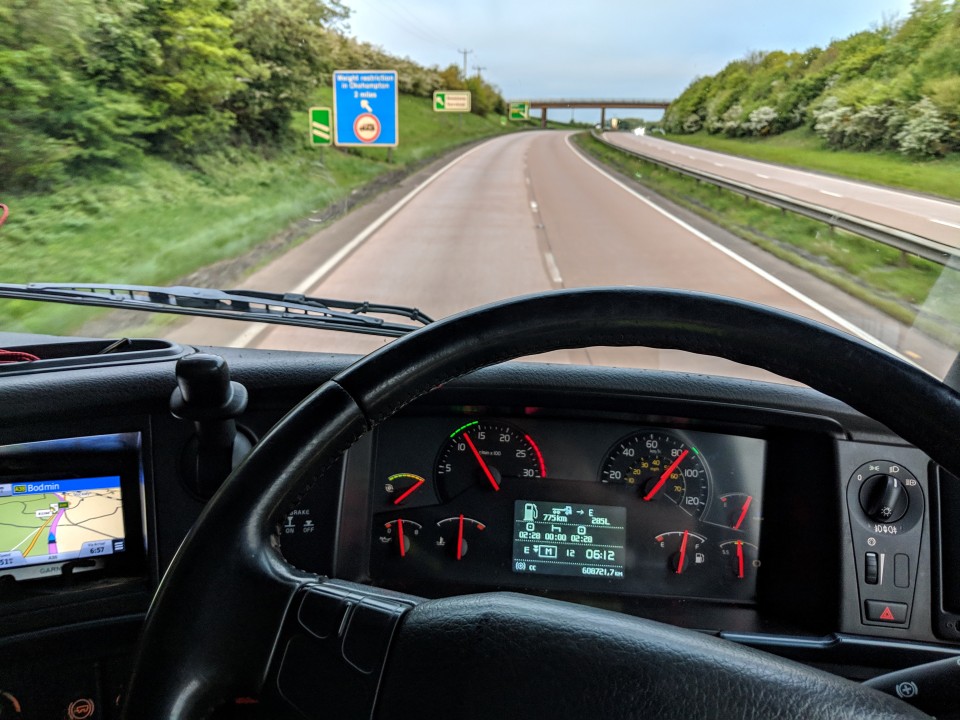
Susie Jones
Le regole del tachigrafo semplificate
Creato: 01/08/2024
•
Aggiornato: 08/08/2024
Il mondo delle regole del tachigrafo può confondere anche il conducente più esperto. Figuriamoci per chi si affaccia per la prima volta nel settore. Il nostro obiettivo è quello di chiarire un po' di questa confusione.
Cos'è un tachigrafo e perché ce l'abbiamo?
Secondo il dizionario, il cronotachigrafo è "un dispositivo che viene installato su veicoli come camion e pullman per registrare informazioni quali la velocità del veicolo, la distanza percorsa e il numero di pause effettuate dal conducente".
Lo scopo del tachigrafo è quello di prevenire la stanchezza del conducente e di garantire che i conducenti e i datori di lavoro rispettino le regole. L'ente di beneficenza per la sicurezza stradale Brake ha riferito che "quattro incidenti su dieci legati alla stanchezza coinvolgono qualcuno alla guida di un veicolo commerciale". Pertanto, le regole del tachigrafo svolgono un ruolo fondamentale per ridurre questo numero.
Quando è necessario un tachigrafo?
È necessario installare un tachigrafo se il peso lordo del veicolo supera le tre tonnellate e mezzo. È importante ricordare che questo include il traino di un rimorchio. Esistono alcune eccezioni a questa regola:
Se si guida solo su strade pubbliche
Se il veicolo è guidato da forze armate, polizia o vigili del fuoco
Se siete una flotta commerciale e utilizzate veicoli con un peso massimo di sette tonnellate e mezzo, e il viaggio è inferiore a 100 km dalla vostra base operativa.
Se trasportate merci e il vostro veicolo è elettrico
Se si trasportano attrezzature o macchinari ad uso del conducente e la guida del veicolo non è la propria attività principale.
Quali sono i diversi tipi di tachigrafi?
Esistono tre diversi tipi di tachigrafi:
Analogico: Sono stati resi obbligatori in Europa nel 1986. I tachigrafi analogici utilizzano fogli di carta oleata per registrare i dati del conducente. I conducenti inseriscono manualmente i dati e li inseriscono nel tachigrafo.
Digitale: Sono stati introdotti nel 2006. Sono utilizzati da più di un milione di aziende di trasporto e da oltre sei milioni di conducenti professionisti. I tachigrafi digitali registrano i dati del conducente su un dispositivo di memoria interno e su una carta del conducente.
Intelligente: A partire da giugno 2019, l'Unione Europea ha imposto alle aziende l'utilizzo di tachigrafi intelligenti. Questi registrano automaticamente la posizione del veicolo all'inizio e alla fine di ogni viaggio. Forniscono inoltre aggiornamenti ogni tre ore
Cosa significa ogni simbolo del tachigrafo?
Guardate il nostro video che spiega ogni simbolo del tachigrafo
Regole di interruzione
Per la sicurezza del camionista e di tutti gli altri utenti della strada, è necessario rispettare le regole di interruzione. Ne abbiamo elencato i punti chiave.
Tempo di guida:
- Non può superare le quattro ore e mezza prima di una pausa.
Pause:
- Devono essere di almeno 45 minuti, a meno che l'autista non faccia un periodo di riposo.
Periodo di riposo:
- Durante un periodo di riposo, non è possibile guidare o svolgere qualsiasi altro lavoro.
Suddivisione delle pause:
Una pausa completa di 45 minuti può essere suddivisa in una pausa di 15 minuti seguita da una di 30 minuti.
Le interruzioni per frazionamento devono essere distribuite nelle quattro ore e mezza di guida.
Secondo le norme dell'UE, se le pause sono suddivise, la seconda pausa deve essere di almeno 30 minuti.

Limite di guida giornaliero
Il limite di guida giornaliero si riferisce al tempo massimo di guida in un giorno. Il limite massimo è di nove ore, ma può essere aumentato a dieci. Tuttavia, questo non può essere fatto più di due volte in una settimana fissa. Il tempo di guida giornaliero può essere definito come:
Il tempo di guida totale accumulato tra la fine di un periodo di riposo giornaliero e l'inizio del periodo di riposo giornaliero successivo.
Il tempo di guida totale accumulato tra un periodo di riposo giornaliero e un periodo di riposo settimanale. .
Limite di guida settimanale e bisettimanale
I conducenti devono assicurarsi di non superare i limiti massimi di guida settimanali e bisettimanali.
Il limite massimo settimanale di guida è di 56 ore (si applica a una settimana fissa).
La settimana fissa inizia alle ore 00.00 e termina alle 24.00 della domenica successiva.
Il limite di guida bisettimanale è di 90 ore.
Riposo giornaliero
Inoltre, è necessario un riposo giornaliero.
Il conducente deve effettuare 11 ore continue di riposo. Questo periodo può essere ridotto a nove
Questa riduzione può avvenire solo fino a tre volte tra i periodi di riposo settimanale.
Il periodo di riposo deve essere completato entro 24 ore dalla fine dell'ultimo periodo di riposo giornaliero o settimanale.
Il riposo giornaliero può essere effettuato nel veicolo, ma è necessario disporre di strutture per dormire adeguate. Se queste strutture non sono presenti, l'autista deve trovare una sistemazione. Consultate la pagina località per scoprire quali autogrill offrono questo servizio.
Riposo settimanale
I periodi di riposo settimanale devono essere effettuati entro e non oltre la fine di sei periodi consecutivi di 24 ore dalla fine dell'ultimo riposo settimanale.
I conducenti sono tenuti a riposare per almeno 45 ore.
Possono usufruire di un riposo settimanale ridotto di almeno 24 ore.
Il riposo settimanale ridotto deve essere compensato in un blocco e almeno nove ore prima della fine della terza settimana.
Sebbene sia possibile usufruire di un riposo ridotto, è bene notare che in due settimane consecutive in cui si è usufruito di un riposo ridotto, una deve essere di 45 ore.

Multi manning
Alcuni autisti possono prendere a bordo un altro autista. I vantaggi sono una maggiore produttività, un chilometraggio più elevato e un tempo di guida più lungo.
Entrambi i conducenti devono effettuare nove ore di riposo giornaliero
Questo riposo giornaliero deve essere effettuato entro 30 ore e non 24.
La prima ora di multi-manning non richiede un altro conducente. Dopo un'ora diventa obbligatorio.
Traversate in traghetto o viaggi in treno
Come già detto, il periodo di riposo giornaliero regolare di un conducente deve essere di 11 ore continuative, tuttavia esistono alcune eccezioni a questa regola. A condizione che il veicolo sia accompagnato dal conducente, i periodi di riposo giornaliero possono essere interrotti due volte, ma non devono superare un'ora in totale. Ad esempio, l'imbarco e lo sbarco da traghetti e treni.
Se il regolare periodo di riposo giornaliero viene interrotto in questo modo, il periodo di riposo accumulato deve essere di almeno 11 ore o 12 se suddiviso.
Cos'è la regola del tachigrafo di un minuto?
La regola del minuto è entrata in vigore nell'ottobre 2011. Si riferisce alla vecchia legislazione che prevedeva che un minuto con almeno cinque secondi di guida dovesse essere registrato come tempo di guida. Tuttavia, l'UE ha modificato la normativa in modo che la singola attività continua più lunga svolta nell'arco di un minuto venga registrata come attività specifica.
Cosa succede se non seguo le regole del tachigrafo?
Il mancato rispetto delle regole del tachigrafo può comportare multe e talvolta la reclusione. In genere, la pena dipende dalla gravità della violazione. La maggior parte delle violazioni del tachigrafo viene trattata con sanzioni fisse. I conducenti hanno fino a 28 giorni per prendere in considerazione le sanzioni fisse.
Nel Regno Unito esistono due tipi di multe e sanzioni.
Multe di quarto livello: il limite massimo è di 2.500 sterline; questo limite si riferisce a ciascuna multa per tacho. Tuttavia, nei casi di infrazioni multiple di livello quattro si può incorrere in una multa massima per ogni infrazione.
Ammenda di livello cinque: il limite massimo è di 5.000 sterline, tuttavia, come per le ammende di livello quattro, i casi di infrazione multipla possono incorrere nell'ammenda massima.
Le regole del tachigrafo possono essere difficili da comprendere. Tuttavia, il mancato rispetto di tali regole può comportare problemi di sicurezza e potenziali multe. Comprendendo e rispettando le regole, le flotte e i conducenti possono utilizzare i loro veicoli in modo sicuro e legale. È importante notare che le norme e i regolamenti sul tachigrafo possono variare a seconda del Paese.



